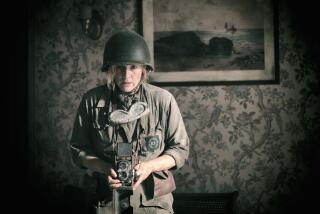Review: Can Spike Lee’s ‘She’s Gotta Have It’ reboot keep up with the strong TV women he helped make possible?
- Share via
Spike Lee’s Netflix reboot of his 1986 breakthrough film, “She’s Gotta Have It,” occupies an odd space of being both timely and dated.
It arrives as women’s issues and bigotry are front and center in the media and entertainment, but also draws from an era when ideas about sexual harassment, gender roles and systemic racism were less explored on screen.
The 10-episode series, premiering Thursday, follows the same basic story of Lee’s original film: Aspiring Brooklyn artist Nola Darling is on a quest to define herself, her sexuality and her womanhood in the face of societal sexism, racism and the smothering demands of her three lovers.
Lee now must compete with contemporary productions that his early work helped inspire.
But just as Brooklyn, and more specifically her neighborhood of Fort Greene, has drastically changed in the 30-plus years since Lee first ruffled feathers with his indie release so has film and TV’s representation of women.
Lee, 60, who directed the entire series and wrote the first and last episodes, now must compete with contemporary productions that his early work helped inspire.
Namely, Issa Rae’s “Insecure.” Her HBO masterpiece (starring, co-created and written by Rae) captures the humor, pain and complexity of four black women facing the uncertainty of their 30s in the rapidly changing environs of Los Angeles and post-Trump America.
The Netflix comedy/drama, however, is too busy updating an old story for a new generation to pay attention to what’s happening on that other platform and coast.
The opening sequence for each 30-minute episode of “She’s Gotta Have It” is a moving and powerful montage of photos from Brooklyn way back when (pre-1990?), and now. Those few seconds convey the gentrification and changing face of Brooklyn so succinctly that each installment starts with a strong underpinning of local history and culture.
But the first four episodes reviewed here struggle to stay current, though they all have hashtagged titles — #LuvIzLuv, #DaJumpOff — and interludes that indicate Nola (DeWanda Wise) is a new woman in a new era.
Understatement has never been Lee’s style. His searing commentary on race and stereotypes riled critics and Hollywood, cracking open the door for black filmmakers in the ‘80s, ‘90s and beyond. But for this series about a woman’s journey toward empowerment, his hammer-away approach backfires for a few reasons, the first of which is that Lee is not a she.
Nola expresses that she wants to dress and act according to how she feels, but complains to her therapist that “the male gaze” inhibits her sense of freedom. It’s a valid point most women can relate to. But the worst offender here is the camera, which ogles at Nola throughout — in bed with lovers, lounging around alone in high-end lingerie or on a date in the black dress she bought as an expression of freedom but that men (and the camera) see as something they want to peel off her.
If the idea was to illustrate the everyday exploitation of women’s sexuality, it does just that, but likely from an unintended angle.
The second issue is scenes meant to be satirical jabs at piggish male behavior are so focused on the men they diminish Nola’s plight. For instance, she’s cat-called on the streets by male caricatures so comical and cartoonish, their presence overshadows her feelings of anger and degradation. It becomes more about them than her.
Lastly, dated references spoken by millennial characters make it difficult to stay firmly planted in their world: Is there anyone in their 20s who’d refer to a cinephile friend as an “Ebert”? Or when Nola’s friends complain about the rising cost of living in the neighborhood, one culprit is the “A-Rab” bodega that sells overpriced milk. Arabs hardly represent a new wave of interlopers along DeKalb Avenue, making even the stereotypes here throwbacks to an earlier era.
The series is co-created and executive produced by Lee’s spouse, Tonya Lewis Lee, and the majority of the episodes were written by women such as Radha Blank and Lee’s sister, Joie Lee, who also plays Nola’s mother. Despite their input, Nola feels like a projection from the male perspective rather than a character created and informed by women.
Her suitors still bear the names of their predecessors from the film. Narcissist Greer Childs, married banker Jamie Overstreet and the B-Boy originally played by Lee, sneaker-wearing Mars Blackmon, are now played, respectively, by Cleo Anthony, Lyriq Bent and “Hamilton’s” Anthony Ramos. All provide comic relief as they play convincingly smitten characters who stumble and fumble around Wise’s gorgeous and determined Nola.
But given how many other great scripted series have emerged in the past five years alone with strong female leads — “Jane the Virgin,” “Chewing Gum,” “The Handmaid’s Tale” and “black-ish” —“She’s Gotta Have It” is best remembered as the film that kicked it all off rather than a series struggling to keep up.
‘She’s Gotta Have It’
Where: Netflix
When: Any time, starting Thursday
Rating: TV-MA (may be unsuitable for children under the age of 17)
ALSO
‘I am inherently politicized’: DeWanda Wise on becoming Spike Lee’s millennial Nola Darling
Netflix’s ‘Rodney King’ has Spike Lee and his muse looking back
Review: Spike Lee’s ‘Michael Jackson’s Journey From Motown to Off the Wall’ really shakes it down
With ‘Chi-Raq,’ Spike Lee takes on gun violence — and angers Rahm Emanuel
More to Read
The complete guide to home viewing
Get Screen Gab for everything about the TV shows and streaming movies everyone’s talking about.
You may occasionally receive promotional content from the Los Angeles Times.







